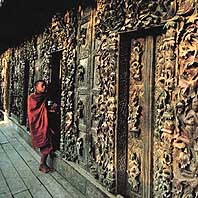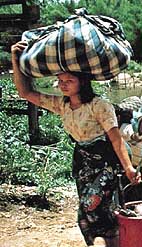Shaped like a kite, trailing its tail along the sea,
Myanmar is the largest country on the Southeast Asian mainland. Although
considered a poor nation, it is rich in history and culture. The Burmans, the
dominant ethnic group, inhabit the Irrawaddy River Basin. But groups with
their own states include the Karens, Chins, Shans, Kayahs, Arakanese, Mons and
Kachins, and retain their distinctive culture and rural customs.
 Intricately
carved teak panels decorate the Shwe Nandow Monastery in Mandalay
Intricately
carved teak panels decorate the Shwe Nandow Monastery in Mandalay
This ancient land seems dormant and reclusive compared to
its neighbours. Myanmar is, however, welcoming more tourists to travel within
its borders. Some regions of the nation are not open to unaccompanied travel,
but those areas which can accommodate the sojourner give a glimpse into a
traditional way of life which is fast disappearing in more modern Asian
countries.
Buddhist monasteries and shrines almost beyond numbering
make Yangoon, the nation’s capital city, a holy city, even though there has
been a new crop raised of modern hotels and restaurants serving Western food.
The massive Shwe Dagon Pagoda rises 326 feet into the air. This dazzling stupa
glitters above the city like a second sun. Begun 2,500 years ago to enshrine
eight hairs of the Lord Buddha’s head, legend has it that the top is
sheathed in millions of dollars worth of gold, and capped with a bud of real
diamonds and other precious stones.
 The
head-shaving ceremony marks this young boy’s initiation into the monkhood
The
head-shaving ceremony marks this young boy’s initiation into the monkhood
Through the eerie and isolated splendour of
thousand-year-old Pagan, one can walk amid literally thousands of pagodas. We
are overwhelmed by such prodigies of faith. These some two thousand temples
are remnants of Burma’s first imperial capital, and follow an eight mile
long curve of the Irrawaddy River. They are also a backdrop for the labours of
farmers in the region where the people live out their days tied to the land.
Here the earth’s rhythms of seasons, planting and harvest dictate the
village life, and their religion eases their souls.
 A
young village girl shows us a simple way of life
A
young village girl shows us a simple way of life
Even though much of Myanmar is still tribal in many ways,
Buddhism has been, and still is, the most lasting and obvious influence in the
country. Holy words, written in stone, fill marble slabs housed in 729 stupas
at the Kuthodaw Pagoda. This impressive undertaking of faith and piety is
often called the world’s largest book. It was created in 1872 under the
orders of King Mindon, with the help of 2,400 Buddhist monks. And when it was
finished, it would take 6 months for these monks to merely recite the text!
Here and there we find reminders of Myanmar’s British
colonial past. The colonial facades of the town of Maymyo still stand. Set in
the cool highlands above Mandalay, Maymyo was once a summer headquarters for
British officials. Today, instead of dress parade for British soldiers, we
will find a line of Buddhist nuns filing down the streets on their daily walk
for alms. The silence of daybreak reveals a pocket in Southeast Asia where
time seems to have stood still, and an old way of life remains.